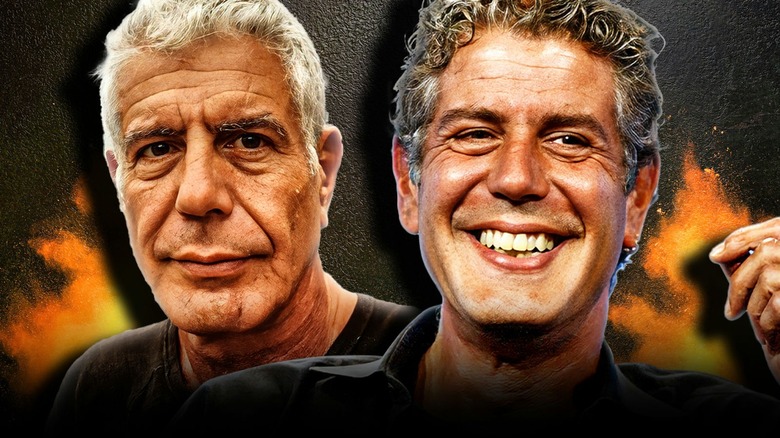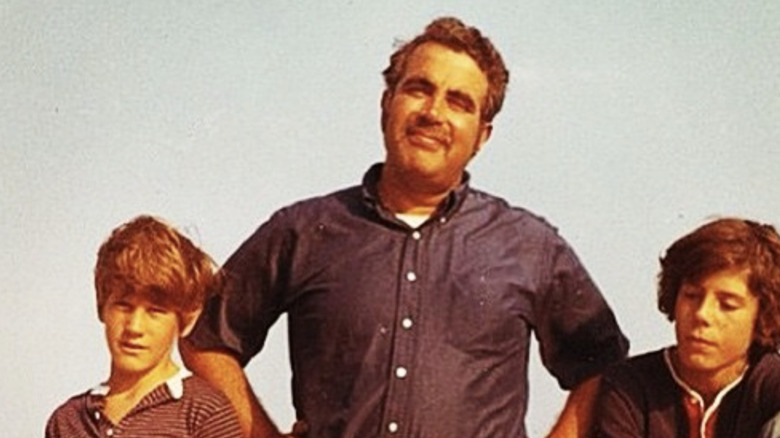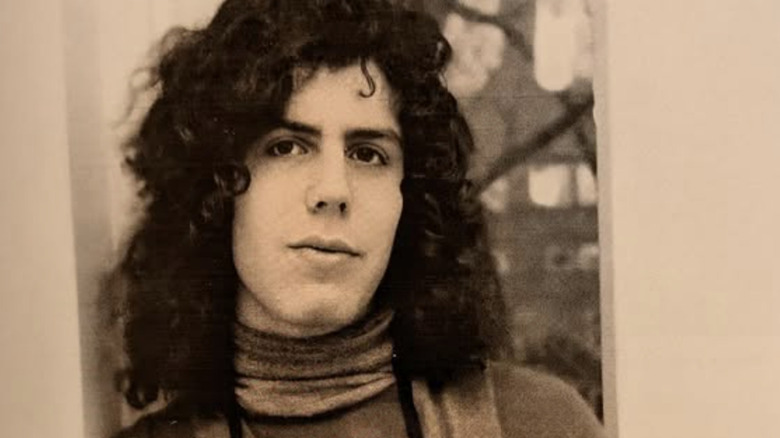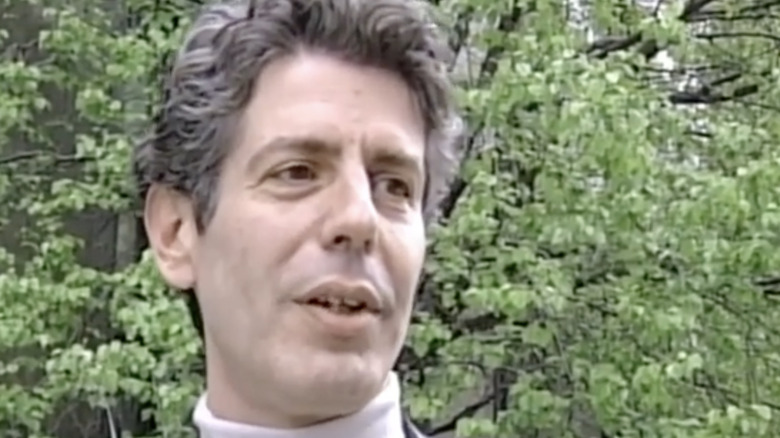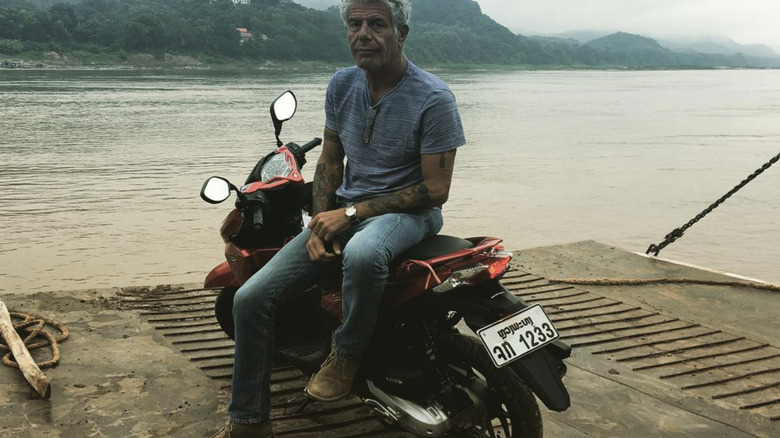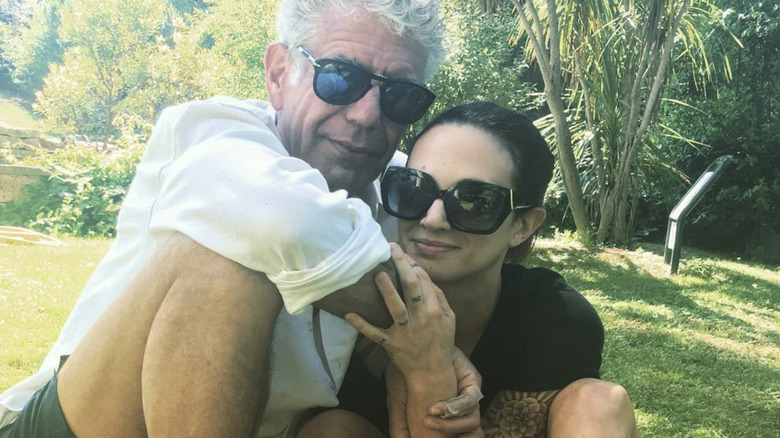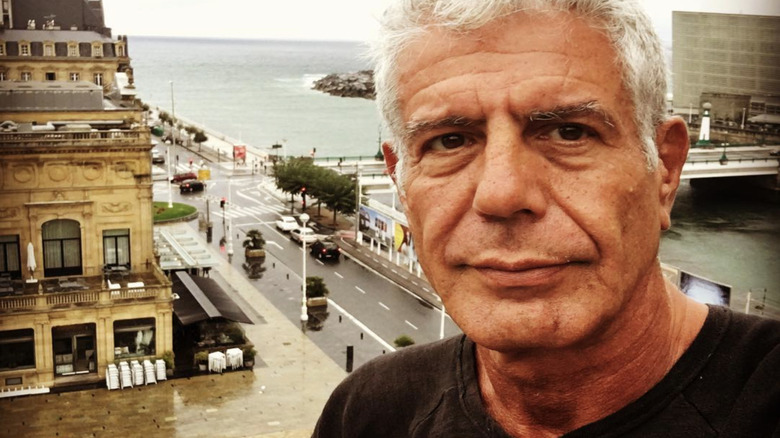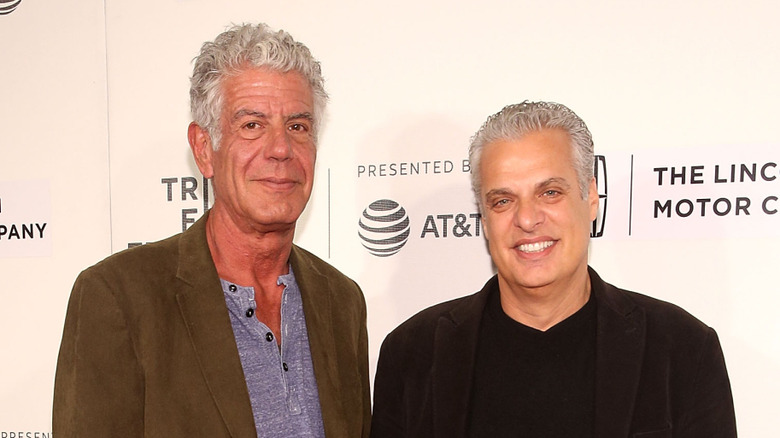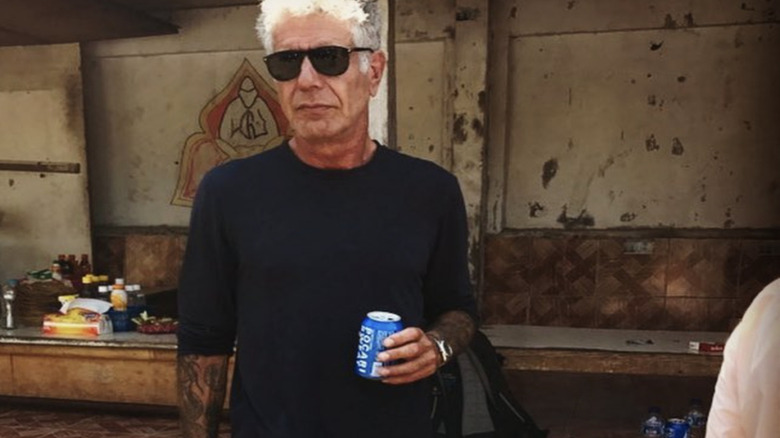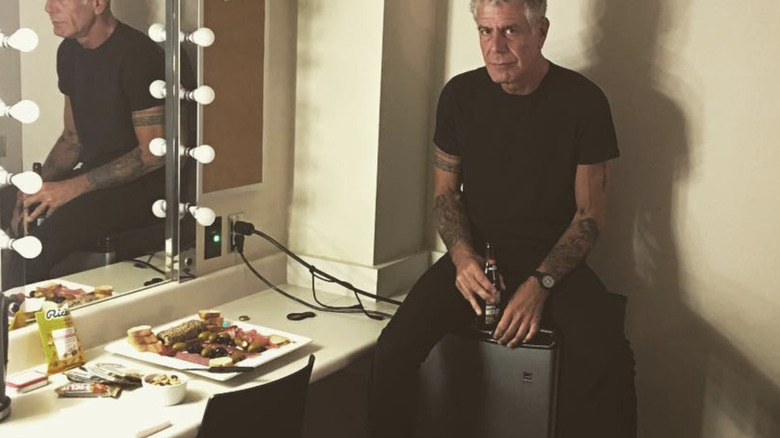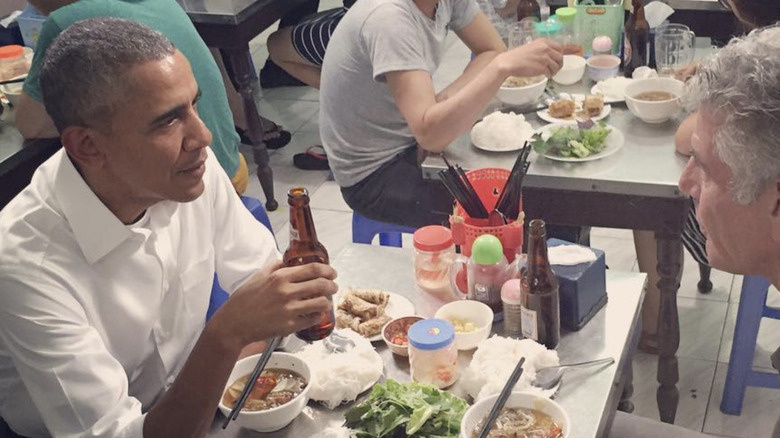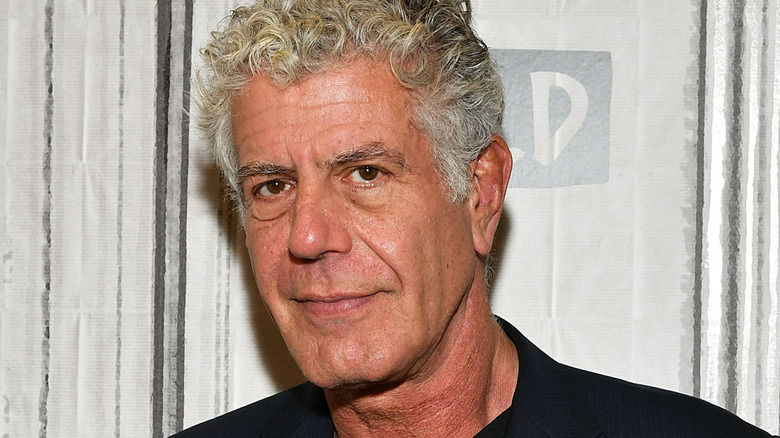What The Cameras Never Showed You About Anthony Bourdain
It's hard to stop talking about Anthony Bourdain. Since his tragic death by suicide on June 8, 2018, there has been a public outpouring of all things Bourdain: the complex, charismatic chef turned globe-trotting documentarian whose quests for authentic cultural experiences inspired so many. But who was Bourdain really? Some of the most interesting insights we've gotten about off-camera Bourdain have come from his family and friends.
Bourdain's confessional, self-deprecating style of storytelling was what catapulted him to celebrity status in the first place. His 2000 memoir "Kitchen Confidential: Adventures in the Culinary Underbelly" introduced Bourdain to the world as a brash, flawed chef with a punk rock edge and boyish romanticisms about food and the human experience. Later, these ideologies played out on television through Bourdain's beloved series "No Reservations" and "Parts Unknown." His sardonic wit and openness made viewers feel like they knew him, but those close to Bourdain have speculated that on-screen, he played a caricature of himself.
This doesn't mean that Bourdain was ingenuine in his work — he was actually quite the opposite. It means that the Bourdain people saw in public only scratched the surface of an emotionally intense man who remained consistently awestruck by his level of fame. These are the parts of Bourdain's life that the cameras didn't see.
He was half-French
For someone who traveled to France as much as Anthony Bourdain did, he didn't come off as someone who was super in touch with his French side. It's fair to say that many fans of Bourdain's TV work didn't even know he was half-French. On his popular series "No Reservations" and "Parts Unknown," fans viewed him as an American-born citizen of the world. Yet in his formative years as both a child and as a travel documentarian, Bourdain explored his roots more directly.
Bourdain was raised in Leonia, New Jersey, but his father, Pierre Bourdain, was French. In his youth, Bourdain spent summers visiting relatives in Arcachon, France, a seaside town just south of Bordeaux. In a piece for Bon Appétit in 2012, Bourdain elaborated on simple Arcachon memories, like, "Eating sandwiches: saucisson a l'ail or jambon blanc. I remember very well the texture of crusty baguette, the smear of French butter, the meat, the inevitable grain of sand between the teeth."
Technically, the cameras did grant a glimpse of Bourdain's heritage — but it's a deep cut. Circa 2001, Bourdain filmed his first show, "A Cook's Tour" as an accompaniment to his book of the same name (and the follow-up to "Kitchen Confidential"). In an episode entitled "Childhood Flavors," Bourdain and his younger brother Chris travel through Arcachon together for the first time in 25 years. They revisit authentic French foods like la soupe du pêcheur and oysters that first ignited Bourdain's culinary curiosity.
Bourdain and his first wife were high school sweethearts
As a teenager, Anthony Bourdain was drawn to what he called the "bad girl" type, someone to complement the rebellious, rock 'n roll image he'd cultivated while attending Dwight-Englewood, a private high school in northern New Jersey. Bourdain ran with a bad crowd and fell hard for Nancy Putkoski. She was a year older and also hung around edgy, drug-using teens. Bourdain was so taken with Putkoski that he graduated high school early and followed her to Vassar College in Poughkeepsie, New York.
"I arrived at 17 ... I was an unprepared, immature young man in the company of very many female wolves, who pretty much taught me the way of the world." Bourdain told Daily Life in 2012. In that same interview, Bourdain called Putkoski, whom he married in 1985, his "partner in crime." According to those who knew the former couple, it was an accurate description. In a 2021 New York Post article profiling the book "Bourdain: The Definitive Oral Biography," one of Bourdain's childhood friends was quoted as saying, "When Tony's dad died, they got some money, and it just went into their veins." Another friend remembers Putkoski being, "almost like his mother."
Bourdain cites the two-year period he spent traveling to film "A Cook's Tour" as the straw that broke his nearly thirty-year relationship. Bourdain's newfound fame and prolonged absences for work proved more than Putkoski could handle. She filed for divorce, and their marriage officially ended in 2005.
Before Kitchen Confidential, Bourdain had already published two novels
Anthony Bourdain didn't go from obscure restaurant cook to celebrity status overnight. He maintained that he was an unlikely success story, and in some ways he was right, but before Bourdain's memoir "Kitchen Confidential" made him a breakout star, he was already a published novelist. In the '90s, Bourdain published two crime novels. His debut, "Bone in the Throat: A Novel of Death and Digestion" came out in 1995 and "Gone Bamboo" was released in 1997. Both novels were originally published by Villard Books. After the huge response "Kitchen Confidential" received, Bloomsbury released a paperback edition of "Bone in the Throat."
Like "Kitchen Confidential," "Bone in the Throat" also depicted the culinary underbelly of New York City, albeit in a more fantastical sense. It was centered around a young chef who takes a restaurant job in Little Italy that has ties to the mafia. "Gone Bamboo" also delves into the mafioso theme, but without the chef angle. Both novels were modest successes. Speaking to Wealthsimple Magazine, Bourdain said, "I was given a $10,000 advance for 'Bone in the Throat,' which I split 50-50 with my old college roommate, who got me into book publishing. For the second book, 'Gone Bamboo,' I probably walked away with around eight grand."
Two years before his death, Bourdain tried to quit Parts Unknown
Anthony Bourdain's prolific career showed no signs of slowing down in 2016. That almost changed when Bourdain met with his executive producers and longtime collaborators, Lydia Tenaglia and Chris Collins, to talk about his desire to quit "Parts Unknown." Tenaglia and Collins, who first approached Bourdain about filming "A Cook's Tour" 17 years earlier, recalled the meeting in 2021's "Roadrunner: A Film About Anthony Bourdain."
Bourdain expressed regret about how his near-constant travel schedule had broken up his family. He said he wanted to focus on his relationship with new girlfriend, Asia Argento, whom he'd met while filming a "Parts Unknown" episode in Rome. Tenaglia remembers Bourdain looking worn-out and stressed during the conversation.
Quitting "Parts Unknown" was no small feat. If he left, Bourdain would be calling lights out on CNN's most-watched series. Still, his producers said it was okay if he couldn't do it anymore. Collins recalls feeling like Bourdain wanted them to beg him to keep making the show. They didn't, and Bourdain never quit. He suspected that the reason Bourdain was never able to walk away from "Parts Unknown" was because he couldn't separate the show from himself.
He could be emotionally needy
When filmmaker Morgan Neville set out to tell the story of Anthony Bourdain's life in his documentary "Roadrunner," he interviewed many of the people who knew Bourdain best. Neville wanted to understand how someone as charismatic and successful as Bourdain could succumb to such darkness. He discovered that beneath the image of Bourdain — consummate world traveler — was a person who was in a great deal of emotional pain.
"He never wanted to stop and actually take stock of what was happening. Part of that is what made him interesting, great as a personality, and compelling to watch. But part of it made him an incredibly vulnerable person." Neville told Vanity Fair in 2021. Bourdain's emotional desperation was most notoriously exhibited in his relationship with Italian actor and director, Asia Argento. Friends describe his infatuation with Argento as emotionally immature, or teenage-like. A rift in their relationship eclipsed much of Bourdain's final hours. Bourdain was distraught over seeing paparazzi photos of Argento in the arms another man. She maintains they had an open relationship.
Bourdain's emotionally fraught feelings over Argento were similar to emotions he experienced after the demise of his first marriage. Bourdain chronicled his bouts of aimlessness and suicidal ideations in his 2010 book "Medium Raw." To numb the pain of his impending divorce, Bourdain went on a bender in the Caribbean, where alcohol, marijuana, and trips to the brothel fueled his "nightly attempts at suicide."
If you or someone you know is struggling or in crisis, help is available. Call or text 988 or chat 988lifeline.org
Off-camera, Bourdain was shy
The version of Anthony Bourdain fans know best (effervescent and snarky, an eloquent trash-talker of the highest order) is not who he always was — on-camera or off. In essence, he was a shy person. The people who worked with or interviewed Bourdain over the years note that outside of his role as the world's #1 tour guide, he didn't talk too much. In fact, the title of international tour guide didn't come naturally either.
In the beginning, Bourdain struggled to make eye-contact with the camera. The pilot episode of "A Cook's Tour" titled "A Taste of Tokyo" is one of the few pieces of documented evidence of that early shyness or uneasiness. Producer Lydia Tenaglia, who worked with Bourdain from day one of his TV career told Vice in 2017, "That first episode, you can see Tony's like a deer caught in the headlights ... We would go back to the hotel and be like, 'We're so f***ed. This is terrible!'"
Tenaglia's partner (in media production and in life), Chris Collins seconded her view on Bourdain's timid nature. Shortly after Bourdain passed away, Collins said to GQ, "People's idea of Tony is formed after 20 years of watching him on television, and there's a sense of like 'This guy is the un-muscled James Bond.' In fact, he was actually a shy man."
Close friend Eric Ripert was one of the last people to see Bourdain alive
Anthony Bourdain's friendship with Eric Ripert, the French-born chef and owner of renowned NYC restaurant Le Bernardin was something the cameras captured often. Before they met, Bourdain was an admirer of Ripert's work at Le Bernardin, calling it "craft performed at the highest level." On Ripert's end, he said "Kitchen Confidential" was the first book he read in English. When he finished the book, Ripert invited Bourdain to Le Bernardin for lunch. The two remained friends for the rest of Bourdain's life. In fact, Ripert was one of the last people to interact with Bourdain before his death.
They were an unlikely pair. Ripert said of their friendship: "He comes from a ship with pirates, and I come from the kitchen of [Joël] Robuchon, which is like the army ... but grew quite close." Ripert was also staying at Le Chambard hotel in Kaysersberg, France, the setting for Bourdain's suicide. Ripert and Bourdain shared numerous meals at the hotel restaurant, but when Bourdain failed to turn up for dinner, Ripert was concerned.
The next morning, Bourdain was also absent for breakfast. Ripert called Bourdain's cell phone, but when he received no response, he alerted hotel staff. Reception staff from the hotel entered Bourdain's room and found his body. In the "Roadrunner" documentary, Ripert was asked how he came to terms with Bourdain's death, and Ripert said it is something he does not discuss.
His addictions were escalating
It was no secret that Anthony Bourdain liked his booze. If Bourdain was an alcoholic — something that the media debated in the wake of his suicide — he was a high-functioning one. In the dark final months of his life, however, other sinister habits he'd long given up began to resurface. After Bourdain's death, an unauthorized biography by Charles Leerhsen entitled, "Down and Out in Paradise: The Life of Anthony Bourdain," released in 2022, perpetuated a grisly portrait of the beloved documentarian's final days.
Bourdain quit smoking on the cusp of his daughter Ariane's birth in 2007, but admitted to going back to the habit around the time of his history-making lunch with President Barack Obama in Vietnam in 2016. That same year, he met Asia Argento while filming "Parts Unknown" in Italy. When they began dating, his regression into cigarette smoking was just one of several questionable tendencies he adopted. In his final years, Bourdain was allegedly drinking to the point of blackout and visiting sex workers in his lonely moments. According to "Down and Out in Paradise," Bourdain had also resorted to shooting steroids and was reliant on Viagra in order to keep up with girlfriend Argento, who was two decades his junior.
If you or anyone you know needs help with addiction issues, help is available. Visit the Substance Abuse and Mental Health Services Administration website or contact SAMHSA's National Helpline at 1-800-662-HELP (4357).
The trappings of fame made Bourdain agoraphobic
Part of Anthony Bourdain's charm was his insistence that he had caught such a lucky break in life; that he was just a normal guy who was given the chance to travel the world, eat food, and talk about it. He entered his job as a travel documentarian shakily, unsure of how to properly showcase the food and cultures he was partaking in. Then, he hit his groove, most often in Asia, the continent in which he felt most at home. The fans watching at home, responded with equal enthusiasm. Yet as his fame grew, Bourdain felt his world growing smaller and smaller.
In "Roadrunner" friend David Chang said, "Tony got really famous ... It was just an incessant, nonstop barrage." For years, Bourdain couldn't walk the streets without fanfare, and it chipped away at his reserve. "Roadrunner" filmmaker Morgan Neville describes one piece of footage that didn't make it into the final cut that encapsulates Bourdain's agoraphobia point-blank.
While filming for an episode of Travel Channel's "The Layover" in 2012, Bourdain was in Amsterdam and had just eaten hash brownies. Cameras rolling, he went quiet on the street because he felt everyone was looking at him. In context, it seemed like typical weed-induced paranoia, but it persisted throughout the remainder of Bourdain's life. Neville told Vanity Fair, "He dealt with agoraphobia, shyness, and anxiety. He also had OCD, depression, bipolar episodes, and addictive qualities."
If you or someone you know needs help with mental health, please contact the Crisis Text Line by texting HOME to 741741, call the National Alliance on Mental Illness helpline at 1-800-950-NAMI (6264), or visit the National Institute of Mental Health website.
Bourdain chose the soundtrack and wrote his own voice-overs for Parts Unknown
"Parts Unknown" was a perfect title for what Anthony Bourdain set out to achieve in his TV career. His documented travels, particularly throughout Asia, shed light on cuisines far beyond the limiting scope of the Western world. Bourdain's incessant desire to learn about underrepresented world cultures through "Parts Unknown" changed the way people viewed food. He was the irreplaceable face of the show, and he was also very involved behind the scenes.
Friends describe Bourdain as obsessively organized, and a control freak when it came to how his image was portrayed on television. He wrote all of the voice-overs you hear on his shows and selected the background music too. One standout example of Bourdain's behind the scenes sway was the "Parts Unknown" episode where he shared a meal with President Barack Obama in Hanoi, Vietnam. Bourdain was insistent that "The Boss" by James Brown be included in the episode, no matter how much it cost to license the song. The episode was a meeting for the ages: the new-school foodie president sitting on a plastic stool and taking noodle-slurping cues from the greatest culinary rebel of our time.
He began seeing a therapist shortly before his death
In a particularly haunting episode of "Parts Unknown", Anthony Bourdain went to see a therapist while in Buenos Aires, Argentina. It was believed to be Bourdain's first-ever therapy session. In the episode, Bourdain laid face-up on a couch and explained that he experienced manic thinking patterns a lot of the time and found it difficult to relax. When filmmaker Morgan Neville was putting together the "Roadrunner" documentary, he learned that Bourdain had begun seeing a therapist about eight weeks before his death. "It was both a sign that he understood that he needed it, but also very late for him to be getting it," Neville told Vanity Fair.
Friends and colleagues, like chef turned podcaster David Chang, suspected that one of Bourdain's ongoing psychological issues was that he hadn't sufficiently dealt with the insecurities and turmoil of his past. Bourdain overcame heroin addiction in the 1980s, but his addictive tendencies took hold over other areas of his life. He also had all or nothing tendencies. Be it travel, jiu jitsu, or love, if Bourdain felt passionate about it, he went all in — sometimes to the point of extremes.
Therapy wasn't enough to recenter Bourdain's state of mind. Over the course of his life, drastic, emotive impulsions had been the source for both his undoing and his greatness. In the end, his self-destructive side took over, causing a loss that has been mourned the world over.
